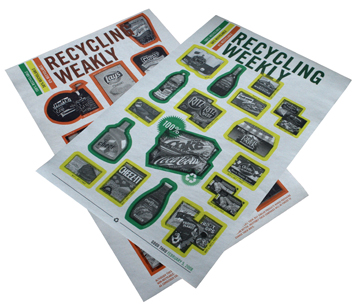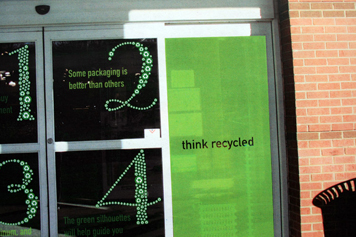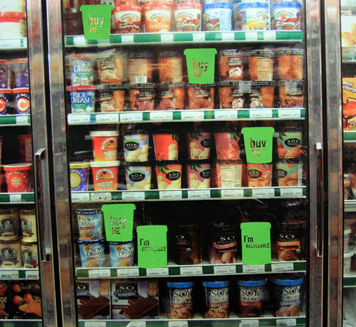
Supermarket door graphics (Design: Caitlin Garrison)
In 1988, the Society of the Plastics Industry developed a resin identification code — a numbering system from 1 to 7 — categorizing different types of plastic. The code is centered in a triangle made of arrows chasing each other. This mark is commonly misidentified as the recycling symbol. Though the system was instituted to “facilitate the recycling of post-consumer plastics,” the chasing arrows graphic is meaningless. Plastic imprinted with the arrow symbol doesn’t indicate that the material is made from recycled content nor that the plastic can be recycled, misleading many.
Did it surprise me that the "recycling symbol" at the bottom of my yogurt container had nothing to do with its recyclability? Yes. (As it turns out, my city doesn’t take #5s.) So why was it there? My curiosity led to findings around which I built a design class.
Too often, we work under assumptions. Or, too often, we work without investigation. As a teacher at North Carolina State University College of Design, I want my students to recognize the former and reverse the latter. Our class is not about recycling per se. It is about understanding the systems we live in, finding the flaws and evaluating them. Our three Rs are research, rethink, redesign.
We started with an exemplary case study, the Green Dot system in Germany (Der Grüne Punkt) where 65% of municipal waste is recycled (compared to 32.5% in the US). With Green Dot, the onus to recycle is placed on the manufacturer, under a “polluter pays” principle. They are responsible for the lifecycle of their product—a strategy changing the way things are made. Recycling starts before manufacturing, at the point of design, not as an afterthought. Packaging has dramatically decreased. Toothpaste doesn’t come in a box. A bottle is reused 25 times before being recycled. All are notable outcomes.
Then our class watched the "Story of Stuff" and "Waste = Food"; we read Cradle to Cradle: Remaking the Way We Make Things and Recycle: The Essential Guide, our essential guide. We went on tour of our local Merf (materials recycling facility). We envisioned the landfill as land-full.
As we became aware, we became depressed. It ain’t easy being green, but worse feeling blue. There is a trash vortex in the Pacific Ocean twice the size of Texas; our landfills mummify waste; plastics hardly decompose, contributing to 60% of beach pollution. Even though the class mascot is a turtle who swallowed a plastic bag thinking it was a jelly fish — named Choking Turtle — we vowed not to use scare tactics to educate (as environmental campaigns sometimes do). Why remind folks that, as noted by Stephen Jay Gould, “Homo sapiens...has limited prospects, entirely self-imposed, for geological longevity.” Instead, we aimed to spread positive messages, to make information accessible, to make people aware.
“To study design is to consider what does not yet exist,” says the dean of our college. We recognized that valuable information is missing from the grocery store. For example, products commonly list content, not container, ingredients. Aren’t both important? So we targeted the supermarket. But how do you inform without infuriating? How do you get people to practice what you don’t want to preach? Laden with grocery bags, why add heavy information to the shopper’s load? A light-hearted dialogue may have enough power to change people’s minds. Thus, we partnered with Dale Carnegie, figuratively, to make friends and influence people. Our graphics wouldn’t “criticize, condemn or complain” but give “honest and sincere” information to “arouse in the person an eager want” to help the environment.

Coupon broadsheet (Design: Britt Cobb)
So we bet on the power of visual wit and charm. This flyer isn't a coupon weekly left in your cart, but a redesigned pamphlet: “Recycling Weekly” on one side, “Recycling Weakly” on the other. The design organizes sale items into recyclable and straight-to-landfill material.

Door graphics (Design: Caitlin Garrison)
At the entryway, large-scale numbers are both instructive and seductive. They ready you for shopping: “Stop before you shop: Some packaging is better than others.”

Caution tape rating system (Design: Susan Baker)
When shopping, you’ll notice that each shelf is coded with colorful construction tape. Green/white stripes indicates a fully recyclable product, made from recycled content. Red/black stripes indicates a landfill product, and is made from non-recycled sources. Other colors refer to partial recycling. This rating system makes you “proceed with caution” as you purchase.

Meat section postcard (Design: David Mitchell)
“The packaging of this delicious meat product cannot be recycled...” states a tromp l’oeil mailer hidden among the meat. This postcard campaign puts pressure on the manufacturer without boycotting the product. You like their product, not their packaging.

Comparison shopping floor graphics (Design: Kristen Morrison)
Point-of-purchase reading: a floor graphic to help you answer the "paper or plastic" question.

Freezer graphics (Design: Caitlin Garrison). Some freezer containers can be recycled. These charming “buy me” door decals help identify them.

Conveyor belt (Design: Rachel Cannon). Colorful conveyor belt with statistical reminders.
Upon checkout (and to help the consumer later at home), our redesigned receipt organizes your purchases into three categories: recyclable, partially recyclable and non-recyclable. An ASCII image of a ruler-wielding nun appears on a receipt with too many straight-to-landfill items. Tsk, tsk.
In our classwork, student studies also included other projects: mirrors strategically placed in the supermarket that say “I am a recycler” (designed by Nida Abdullah); a designer toy point system (designed by Ariana Farquharson); and a signage program hanging from the rafters (designed by Darwin Campa).
Our throw-away society functions on a presumption: somebody else is taking care of this waste. Investigation suggests otherwise. The landfill is a flawed design. Even recycling, in its current mode, is deficient. Only when people become aware of facts, not fallacies, will there be an end to our ecological Dark Ages.
